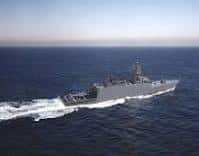 Derived from the French term corvette , the concept of corvette refers to a warship that resembles a frigate , although with less autonomy and tonnage . The name of today's ships comes from ancient ships that had a square sail and three masts.
Derived from the French term corvette , the concept of corvette refers to a warship that resembles a frigate , although with less autonomy and tonnage . The name of today's ships comes from ancient ships that had a square sail and three masts.
Today, corvettes are used to defend territorial waters, carry out surveillance activities or carry out short-duration missions. They have more weapons than patrol boats but, unlike frigates, they are not capable of extensive missions due to their limited autonomy.
The first corvettes, which used to escort merchant ships , fell out of use in the second half of the 19th century . At the time of the First World War , these vessels reemerged with their contemporary characteristics with a displacement that, over time , reached 2000 tons .
Modern corvettes generally have anti-aircraft and anti-ship missile launchers, torpedoes, anti-submarine mortars, sonar and radar . This allows them to carry out various military tasks successfully.
Among the first generation corvettes we can mention the Esmeralda corvette , launched in 1855 and belonging to the Chilean Navy . This ship, which was manufactured in shipyards in England , participated in the Spanish-South American War and the Pacific War ; She was finally sunk in 1879 .
The Buyan-class corvettes , for their part, are modern corvettes that are in the service of the Russian Navy . The Chinese Navy also currently has corvettes assigned to several of its fleets: the Jiangdao warships, also known as Type 056 corvettes .
Flower-class corvette
 Also known as the Gladiolus-class corvette , the Flower class was widely used in the United States, Canada and England throughout World War II. When the confrontation began, the Royal Navy began manufacturing it, for which it had to employ various shipyards. One of them was in France; When the Germans captured it, they took over the four corvettes they were building there.
Also known as the Gladiolus-class corvette , the Flower class was widely used in the United States, Canada and England throughout World War II. When the confrontation began, the Royal Navy began manufacturing it, for which it had to employ various shipyards. One of them was in France; When the Germans captured it, they took over the four corvettes they were building there.
Typically, the total manufacturing period for a Flower- class corvette lasted between 23 and 30 days. It is estimated that approximately two hundred units were built; Each one has an order number preceded by the letter K. Two of the best known are HMS Blue Bell (K80) and HMS Snowberry (K166) .
Regarding their general characteristics, the corvettes were vessels with a displacement of 940 or 1,170 tons (depending on whether it was a standard trip or fully loaded ), a propulsion plant with a boiler that was capable of reaching 16 knots (30 km). /h; its range was 4,000 nautical miles if it moved at 12 knots of speed), four cannons, two Lewis machine guns and an anti-submarine mortar.
The crew of a corvette of this type had 47 officers and sailors. It had two bridges: one open and the other closed. Inside, the distribution had the objective of making the most of every square centimeter. The officers were in the center, while the crew cabins were in the bow and stern.
One of the weak points of the Flower -class corvette is that it did not have protection or armor against torpedoes . Some specialists consider this feature a true "defect" of the design, and rely on the fact that it caused so many losses during the confrontations with German submarines.
When the war ended, some of the corvettes that had survived the battles were put up for sale, and were acquired by individuals or foreign governments; the rest were subjected to scrapping. It is worth mentioning that among these corvettes that survived , so to speak, some were used as harpoon ships, one of the components of whaling fleets.
